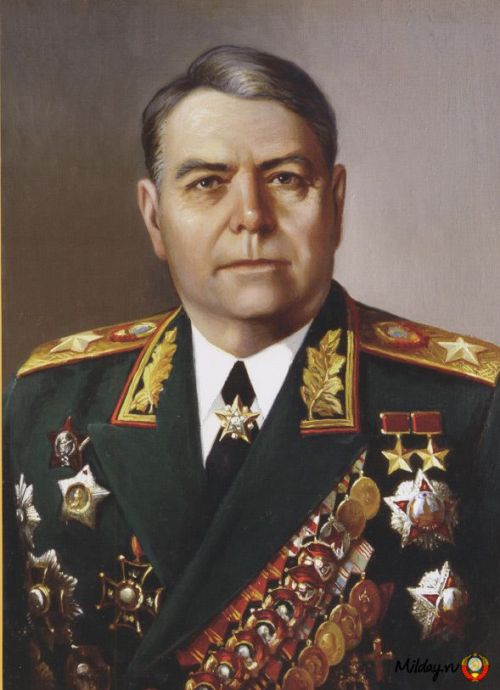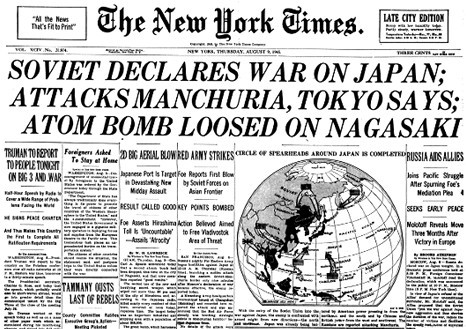The Soviet Invasion of Manchuria, Part II: The Invasion Begins,Due to their humiliating defeat at th
The Soviet Invasion of Manchuria, Part II: The Invasion Begins,Due to their humiliating defeat at the hands of the Soviets during the Battle of Khalkhin Gol in 1939, the Japanese chose to stay out of the conflict between Germany and the Soviet Union during World War II. Soviet leader Joseph Stalin likewise wanted nothing to do with Japan, signing a non-aggression pact with the Japanese as well. However during the Tehran Conference of 1943, Stalin agreed with Winston Churchill and Franklin D. Roosevelt that the Soviet Union would enter the war against Japan once Germany was defeated.Many accused the Soviets of opportunism, since the invasion began on August 9th, 3 days after the Americans dropped the atomic bomb on Hiroshima. However Soviet planning and organization of the operation began in late April, when it was clear that Germany was going to lose the war. The logistics of organizing such an invasion was certainly not easy. The invasion force itself consisted of almost 1.7 million troops, 26,000 artillery pieces, 5,556 tanks, and over 5,300 aircraft. Indeed the operation was one of the largest offensives of World War II, yet all men and material had to be transported thousands of miles across the barren Siberian wilderness, which was no easy task and took time. The men and units chosen for the operation were noted for distinguishing themselves while fighting the Germans. They were also chosen for specialty skills. For example many units who had fought in the Carpathian mountains of the Balkans were selected as the Carpathian mountains were very similar to the mountains of Northern Manchuria. Tank units that had distinguished themselves at the Battle of Kursk were selected as the flat terrain of Kursk was similar to the flat terrain of Central Manchuria. To head the operation, Stalin hand selected Marshal Aleksandr Vasilevsky, an experienced commander who saw combat at Moscow, Kharkov, Leningrad, Stalingrad, Kursk, Odessa, Sevastopol, Belarus, and Konigsberg. Obviously Vasilevsky was the right man for the job. Moreover, Stalin did something he never did with his commanders in the past; he gave Vasilevsky the authority to plan and conduct the operation with complete autonomy, an incredible precedent in the history of Stalinism. The plan of Vasilevsky’s operation was a double pincer movement, with one assault from the west (The Transbaikal Front) and one from the east (the 1st Far Eastern Front). A third force would travel along the Manchurian coast with the goal of invading Japanese held Korea. Without interference from Stalin or the Communist Party in Moscow, Vasilevsky chose an unorthodox strategy to break through Japanese defenses on the first night of the offensive. At the time the Kwantung Army was undermanned, with many of its crack soldiers reassigned to fight the Americans in the Pacific. Regardless, the Kwantung Army was still a formidable fighting force, with 1.2 million men, 1,155 tanks, 5,360 artillery, and 1,800 aircraft. The Japanese had built a line of fortifications near the Manchurian border that was very heavily defended. Standard Soviet war doctrine dictated that an assault begin with a heavy artillery and rocket bombardment, however Vasilevsky feared that such a bombardment would warn the Japanese of an attack. Many Japanese units were situated far behind the lines engaged in training exercises. A bombardment would just attract more reinforcements before the advance could begin.Instead of brute force, Vasilevsky chose stealth and guile to achieve his goals. Selecting his most experienced and toughest troops, he formed small commando units who would be tasked with beginning the assault. On the night of August 9th, 1945, the commandos attacked, using the night as cover for their assaults. The Japanese were taken by surprise, so much so that Soviet commandos accomplished their objectives often with little resistance. Advancing 20km into enemy territory, the commandos captured key objectives such as important trenches, pillboxes, machine guns nests, gun platforms, artillery batteries, airfields, communication centers, supply depots, and command posts. Most humiliating of all, thousands of Japanese, who swore an oath to the emperor to fight to the death, were captured as the Soviets stormed their barracks while they slept. The commando strikes created so much confusion that the Kwantung Army quickly devolved into chaotic mess. The Japanese commander, Otozo Yamada, was taken unawares by the assault, and didn’t arrive to take command until 18 hours later. The next morning, the main advance of the Soviets was to begin. So far, things were going well for Vasilevsky.To be Continued -- source link
#history#soviet union#wwii#manchuria#red army#marshal vasilevsky#kwantung army#japanese history#war#battle

